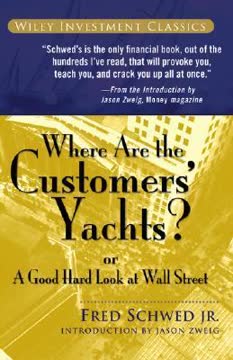Key Takeaways
1. Simplify investing: Focus on asset allocation and low-cost index funds
"Smarter investing is the boring process of deciding what you want your money to do for you in the future, putting your money into a mix of investment building blocks that has a good chance of getting you there, using products that allow you to keep as much of the market returns you make in your pocket rather than giving it to the industry croupier, and sticking to your planned mix through thick and thin – no chasing last year's winning markets or managers please!"
Asset allocation is key. The most critical factor in determining your investment success is getting the right mix of assets in your portfolio. This means balancing equity risks with high-quality, shorter-dated bonds. Diversification across different asset classes and geographical regions helps create a portfolio that can weather various market conditions.
Use low-cost index funds. Implementing your chosen asset allocation using low-cost index funds or exchange-traded funds (ETFs) gives you the best chance of capturing the bulk of market returns. These passive investment vehicles aim to replicate the performance of a specific market index, offering broad diversification at a low cost. By keeping expenses low, you ensure that more of the market's returns stay in your pocket rather than going to fund managers or other intermediaries.
2. Adopt a "lose the fewest points" philosophy instead of trying to beat the market
"The ultimate outcome is determined by who can lose the fewest points not win them."
Avoid chasing returns. Many investors fall into the trap of trying to beat the market by constantly switching between investments or attempting to time market movements. This approach often leads to buying high and selling low, destroying wealth in the process.
Capture market returns. Instead of trying to outperform the market, focus on capturing as much of the market's return as possible. This means:
- Staying invested for the long term
- Avoiding unnecessary trading
- Minimizing costs and fees
- Resisting the urge to react to short-term market movements
By adopting this philosophy, you increase your chances of achieving your financial goals while reducing the risk of making costly mistakes.
3. Understand and control your emotional biases as an investor
"The investor's chief problem – and even his worst enemy – is likely to be himself."
Recognize cognitive biases. Humans are prone to various psychological biases that can negatively impact investment decisions. Some common biases include:
- Overconfidence: Believing you're better at investing than you really are
- Loss aversion: Feeling the pain of losses more acutely than the pleasure of gains
- Recency bias: Giving too much weight to recent events when making decisions
- Confirmation bias: Seeking out information that confirms your existing beliefs
Implement safeguards. To combat these biases:
- Develop a clear investment plan and stick to it
- Avoid checking your portfolio too frequently
- Use automatic rebalancing to maintain your target asset allocation
- Consider working with a financial advisor who can provide objective guidance
By understanding and controlling your emotions, you can avoid making impulsive decisions that harm your long-term financial well-being.
4. Construct a diversified portfolio balanced between growth and defensive assets
"Asset allocation is not a panacea. It is a reasoned – if imperfect – approach to the inevitable uncertainty of the financial markets."
Balance risk and return. A well-constructed portfolio should include both growth-oriented assets (like stocks) and defensive assets (like high-quality bonds). The growth assets provide the potential for higher long-term returns, while the defensive assets help protect your wealth during market downturns.
Diversify across asset classes. Consider including:
- Developed market equities
- Emerging market equities
- Value and small-cap stocks
- Real estate investment trusts (REITs)
- Short-term government and corporate bonds
- Inflation-linked bonds
The specific mix of these assets will depend on your individual circumstances, risk tolerance, and financial goals. By diversifying, you create a portfolio that can perform reasonably well under a wide range of economic scenarios.
5. Choose passive investing strategies over active management
"Don't search for the needle, buy the haystack."
Understand the odds. Extensive research has shown that the vast majority of active fund managers fail to consistently outperform their benchmark indices over the long term. This is due to a combination of factors, including:
- The efficient nature of financial markets
- The impact of fees and expenses
- The difficulty of consistently making accurate predictions
Embrace index investing. By choosing passive strategies that aim to replicate market returns rather than beat them, you:
- Reduce costs
- Increase diversification
- Simplify your investment approach
- Improve the likelihood of achieving your financial goals
While it may be tempting to try to find the next star fund manager, the odds are stacked against you. Passive investing provides a more reliable path to long-term investment success.
6. Regularly rebalance your portfolio to maintain your target asset allocation
"Disciplined rebalancing activity requires a strong stomach and serious staying power."
Maintain your risk profile. Over time, different assets in your portfolio will perform differently, causing your asset allocation to drift away from your target. Regular rebalancing brings your portfolio back in line with your intended risk level and investment strategy.
Implement a systematic approach. Consider these rebalancing strategies:
- Time-based: Rebalance at set intervals (e.g., annually)
- Threshold-based: Rebalance when an asset class deviates by a certain percentage (e.g., 5%) from its target allocation
- A combination of both time and threshold-based approaches
Rebalancing forces you to sell assets that have performed well and buy those that have underperformed, effectively implementing a "buy low, sell high" strategy in a disciplined manner.
7. Be wary of complex financial products and "too good to be true" opportunities
"Perhaps a better working rule of thumb is that the long-term value of an investment opportunity should, as a starting point, be viewed as being inversely related to its sophistication and complexity."
Avoid unnecessary complexity. Many financial institutions create complex products that promise high returns with low risk. These often include:
- Structured products
- Hedge funds
- Private equity funds
- Exotic derivatives
While these may seem appealing, they often come with hidden risks, high fees, and poor liquidity.
Stick to the basics. For most investors, a portfolio of well-diversified, low-cost index funds or ETFs is sufficient to meet their financial goals. If you don't fully understand an investment product or strategy, it's best to avoid it. Remember, if something sounds too good to be true, it probably is.
8. Consider your risk tolerance, capacity, and need when choosing a portfolio
"Make sure that you fully understand what the right balance between ownership and lending (equities and bonds) is that makes sense for you. Understand too, what your investment journey will look like."
Assess your risk profile. When choosing a portfolio, consider:
- Risk tolerance: Your emotional ability to withstand market volatility
- Risk capacity: Your financial ability to absorb losses without jeopardizing your goals
- Risk need: The level of risk required to achieve your financial objectives
Find the right balance. Your portfolio should strike a balance between these three factors. For example, even if you have a high risk tolerance, you may not have the capacity to take on high levels of risk if you're close to retirement. Conversely, you may need to take on more risk than you're comfortable with to meet your long-term goals.
Use tools like risk questionnaires and financial planning software to help determine the appropriate level of risk for your situation.
9. Minimize costs and taxes to maximize long-term returns
"In investing, you get what you do not pay for, as Jack Bogle would say."
Focus on costs. Investment costs can have a significant impact on your long-term returns. Pay attention to:
- Expense ratios of funds and ETFs
- Transaction costs when buying and selling securities
- Advisory fees if working with a financial professional
Even small differences in fees can compound to substantial amounts over time. Always seek out low-cost investment options that meet your needs.
Be tax-efficient. Minimize the tax impact on your investments by:
- Utilizing tax-advantaged accounts like IRAs and 401(k)s
- Holding tax-efficient investments in taxable accounts
- Considering tax-loss harvesting strategies
- Being mindful of the tax implications of portfolio rebalancing
By keeping both costs and taxes low, you ensure that more of your investment returns stay in your pocket, accelerating your progress toward your financial goals.
10. Stay committed to your investment strategy through market volatility
"The hardest work in investing is not intellectual, it's emotional. Being rational in an emotional environment is not easy."
Expect volatility. Market fluctuations are a normal part of investing. Understanding this can help you stay calm during periods of market stress. Remember that historically, markets have always recovered from downturns, even if the timing is uncertain.
Maintain perspective. During market turmoil:
- Review your long-term financial goals
- Avoid making impulsive decisions based on short-term market movements
- Consider reducing how often you check your portfolio
- Focus on factors you can control, like your asset allocation and costs
If you've constructed a well-diversified portfolio aligned with your risk tolerance and financial goals, the best action during market volatility is often to do nothing. Staying committed to your strategy gives you the best chance of achieving long-term investment success.
Last updated:
Review Summary
Smarter Investing receives mostly positive reviews, with readers praising its comprehensive approach to passive investing and long-term strategy. Many appreciate the data-driven arguments and practical advice on portfolio construction. Some find it repetitive and overly wordy, suggesting it could be condensed. Readers value the book's emphasis on low-cost index funds, diversification, and avoiding emotional decision-making. It's particularly useful for UK investors, though some concepts may be challenging for complete beginners. Overall, it's considered a valuable resource for those interested in a rational, evidence-based approach to investing.
Similar Books










Download PDF
Download EPUB
.epub digital book format is ideal for reading ebooks on phones, tablets, and e-readers.




